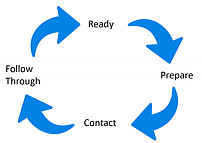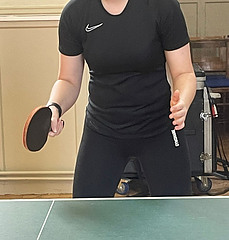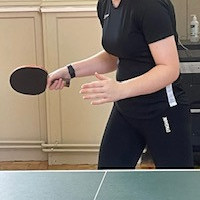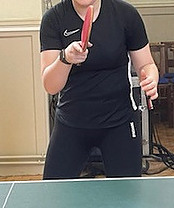
Among the various techniques in table tennis, the forehand topspin is one of the most crucial and effective shots. Mastering this shot requires a deep understanding of its technical aspects. In this article we will delve into the forehand topspin in table tennis exploring its mechanics, coaching points and strategic applications.
Mechanics of the Forehand Topspin
The forehand topspin is a shot that involves imparting a forward and upward spin on the ball. This motion creates topspin, which will drag the ball down on your opponents side. If you get a lot of spin on the ball, after contact with the table, the ball will have a sharp ‘kick’ to it making it difficult for your opponent to return. The aim is to get the balls trajectory as close to the net as possible and as deep as you can on your opponents side to make it much more awkward for them to play a good shot back. The forehand topspin can also deal well with other spins and can be used to counteract backspin. The following points are key to having the basic platform to build your topspin on.
1. Grip – Having the correct grip is vital to be able to execute the forehand topspin. Using the shakehand grip is most commonly used to play the topspin shot. The grip provides a good balance between power and control, allowing you to generate spin while maintaining accuracy. Read our post here on how to correctly perform the shakehand grip.
2. Stance and body position – Standing in the correct stance is crucial for generating power and balance. You should stand with your feet roughly slightly wider than shoulder width apart with bent knees. Think of it like standing how a goalkeeper in football would to save a penalty. Your body weight should be on the balls of your feet so you are ready to move in either direction when needed. Your non playing hand should be held up to keep your balance.
Now we have the fundamentals to build on we can start looking at how to execute the forehand topspin in table tennis. There are four key stages to the forehand topspin. All of which are important and should be followed. These are:
- Ready position

- Back swing
- Contact point
- Follow through
We will now look at each of these points in more detail going through some coaching points with them.
Ready Position
The ready position as previously mentioned is crucial to generate power in your shot. It is also essential to recover back to your ready position after you have completed every shot. As table tennis is such a fast paced game, any second you can get extra to prepare for your shot is going to make a huge difference. Therefore, if you do not recover back to neutral, you may be in the wrong position for your next shot and it takes longer to prepare leading to a weaker shot or missing. For example, after playing a forehand, if you then start the back swing for another forehand too early before the ball has come back your opponent may see this and play the ball to your backhand. You are now out of position and it takes much longer to get yourself and your bat ready to play a backhand shot, in table tennis you do not have enough time between each shot to be doing this. Therefore, recovering back to ready position gives you that vital extra time to prepare for your next shot.
The ready position is simple to execute. Stand on the balls of your feet, with your feet slightly wider than shoulder width apart with a bend in your knee. You should have your toes, knees and shoulders all in a vertical line. If you have these all in a straight line, you are in the correct position. Both arms should be extended out in front of you with a bend at the elbow.

Back Swing
Once we know the shot we are going to perform is a forehand topspin we can now start to prepare for this. Making sure we have the correct grip and stance first, is important to executing a good forehand topspin in table tennis. We have already covered the grip as this is the same from the ready stance. However, the stance changes slightly. Keep your feet roughly shoulder width apart with a bend in the knees so your toes, knees and shoulders are all in a line. The difference between the ready stance and the position for a forehand is very minimal but needed. You should drop your right foot slightly further back (left foot if you are left-handed), this gives you the space needed to rotate and be able to shift your body weight from one foot to the other.
The forehand topspin should be a fluent movement, to start it off we need the correct back swing. The bat should be taken back behind the body, keeping your elbow bent. As you move the bat back you should also transfer your weight onto your back foot which at this point should be your right foot (unless you are left-handed). Doing this should cause a rotation in your waist. Make sure not to swing your bat too far back, it should only be a small movement.

Contact Point
This is where we are going to generate the spin from. Contacting the ball at the correct time and on the correct part of the bat and ball will be very important. First, we will talk about where on the bat and ball we should be making contact. When playing a topspin shot in table tennis you should try to use the middle section of the bat on contact point, this is to get the most control and spin. However, when we make contact on the bat we want to brush the ball. So we should have as much contact time with the ball on the bat, rather than just hitting the ball flat in the middle of the bat. The contact point on the ball will be different depending on what spin your opponent has produced. If your opponent has done a topspin shot, you should contact over the top of the ball. For some, this may seem like it would make the ball go down however, due to the spin, this will not be the case. If your opponent has played a backspin shot to you and you want to play a topspin, you will have to contact it slightly different. If you contact over the top of the ball, it will just drop straight off your bat onto your side of the table. Therefore, you need to come up the back of the ball more to counteract the backspin.
Next is understanding where you should play your shot. You should play your shot slightly in front of you to the right (left if left-handed). Your arm should be bent out towards the right (unless left-handed) giving yourself space between your body and elbow. A good indication it is not too close to you is to place your fist between your elbow and waist. This should be roughly the right distance to keep. You should be able to see the ball and bat when you are making the contact. I like to think of it as when you are writing, you write in front of you so you can see what you are doing. This means you should not be contacting the ball when it is next to you and definitely not when it is behind you.
To transition from the back swing to the contact point, there is going to need to be some rotation. Your hips and shoulders should simultaneously rotate. As this happens you should also transfer your weight from your back foot to your front foot. Doing all of this combined will be where you get your spin from. When playing against a backspin shot, you should drop your weight down more onto your knees and as you rotate come up slightly. The more you use your legs in a topspin shot the more spin you will be able to generate.

Follow Through
The follow through is very important to help complete the topspin shot and helps maintain balance. After contacting the ball, your bat should continue its upward motion across the body. It should roughly finish in line with your face. You should not have your bat going any further than this, as this will increase your recovery time giving you less time to prepare for your next shot. It also takes away a lot of your control. This stage of the shot is important as it is what will help carry the ball over the net. If you stop your swing straight after contact with the ball, it will most likely not make it over the net and will not be powerful. I like to think of if you are boxing, when you punch you wouldn’t stop when contact is made, you follow through to get more power.
After you have finished your shot with the follow through, ending with your bat around face height, you should now go back to the ready position and recover ready to play your next shot. This is very important to do so you can start your next shot much quicker.

Strategic Applications
Being able to master the forehand topspin in table tennis will open up a world of different strategies for you to implement in your game. The following are examples of where this shot can be really effective.
- Attacking play – The forehand topspin is a potent weapon for aggressive players. It allows you to attack your opponents with a fast and spiny shot that can be challenging to return. Having a consistent spiny forehand topspin can put your opponent under a lot of pressure. They may not be able to attack back and may play passively by blocking. It can also force them into making errors. Such as, not reading the spin and blocking the ball long or not playing an effective block causing the ball to be returned to you high so you can play a winning shot.
- Opening opportunities – A well-executed forehand topspin can be used to change defense into attack. If your opponent pushes the ball, you can ‘open up’ by playing a topspin shot. Performing a good open up shot with plenty of spin can put you in good stead to win the point. It will put you in control of the rally playing in a more attacking way. Remember, when playing a topspin shot against backspin you must bend your knees more and contact the back of the ball rather than the top.
- Control and variation – The forehand topspin can be adapted for different situations. You can adjust the amount of spin and speed you put on the ball. This makes it difficult for your opponents to predict what shot you are going to play. You can play one slow spiny shot to draw out a weak ball to then play a faster shot next. Or, you could have played a few faster shots with less spin, then play a slower shot but put more spin on the ball. This can catch a player out forcing them to make an error.
Conclusion
The forehand topspin in table tennis is a cornerstone technique. By mastering this shot, players can elevate their game to new heights. Consistent practice and a deep understanding of the mechanics and coaching points will enable you to execute the forehand topspin with confidence. Once you have practiced this shot and mastered it, you will then be able to implement it into your matches through the strategies mentioned. If you can think of any other strategies using the forehand topspin let us know in the comments below, we would love to hear everyone’s ideas!
If you have any questions feel free to ask them below and we will be more than happy to help you out.



Hi, your detailed technical analysis of the forehand topspin in table tennis is incredibly informative. It’s a shot that requires precision and finesse. I’m curious, do you have any recommendations for drills or exercises that can help players improve their forehand topspin technique? Additionally, are there common mistakes or misconceptions that you’ve observed players make when trying to master this essential skill?
Hi, I am glad you found this post useful! Some simple drills to help refine this technique include, one person blocking while the other performs continuous topspin shots. This can then be advanced to playing one from the wide forehand and one from the middle to introduce some regular footwork. If you want more of an irregular footwork drill, it could be changed to having the blocker block anywhere in the forehand half/two thirds of the table.
Some of the common mistakes I have come across while coaching others include:
> Just using their arm and not their legs/hips
> Following through too much finishing passed their head
> Gripping the bat too tightly
I hope this answers your questions and you are able to practice the forehand topspin. If you have any more questions feel free to ask.
Hi! Thank you for the in-depth instructions on how to improve my top spin. I love playing ping pong/table tennis but for the life of me cannot become consistent with keeping the ball on the table with any authority. I either overdue the top spin and hit the net or blast it off the table. You have provided some great instruction here for me to practice and implement. Fingers crossed I can figure it out, my 8 yr old son is catching up to me ha! any other pointer would be much appreciated.
Hi Matt, thank you for your time to read this post and leave a comment. You can find many posts on our website with some advice on how to improve. Here is a post about how to practice table tennis alone so you can improve and stay ahead of your son!